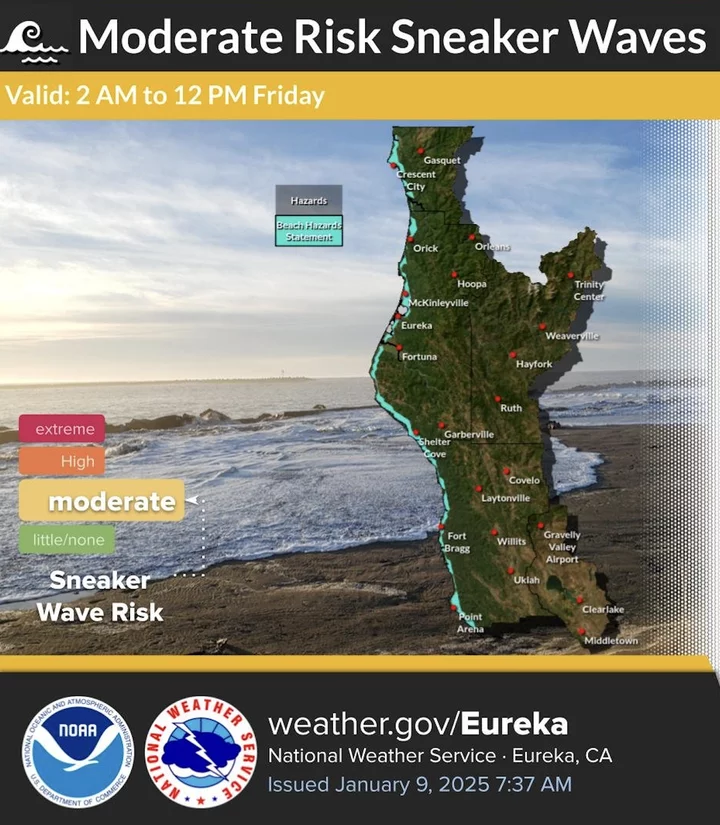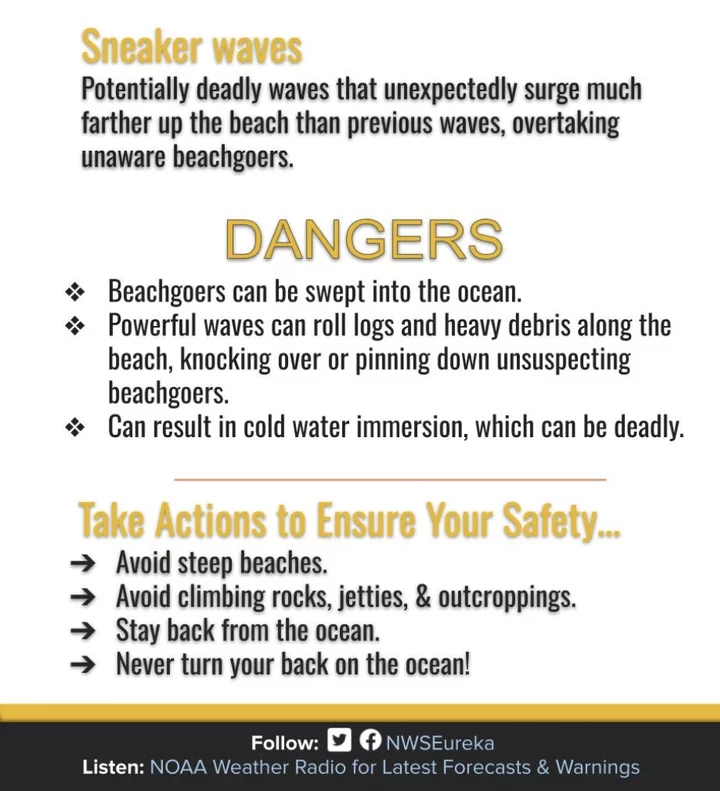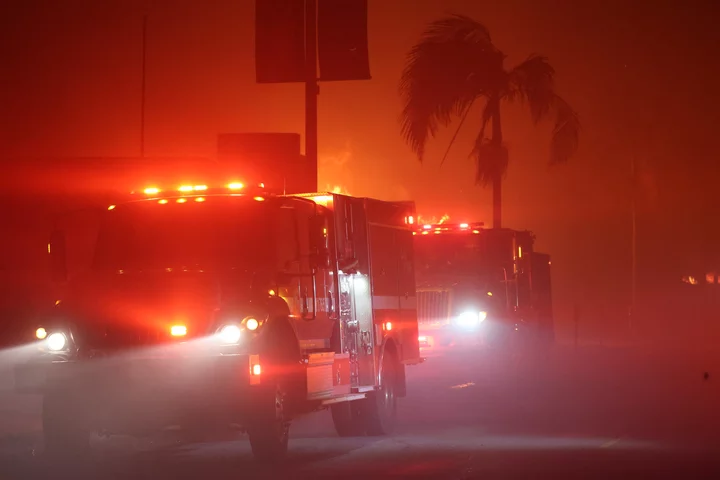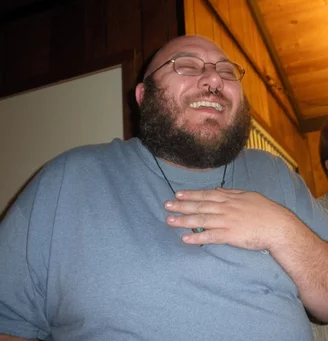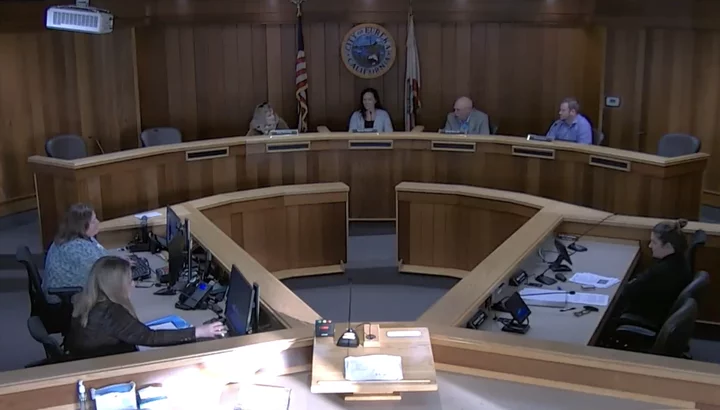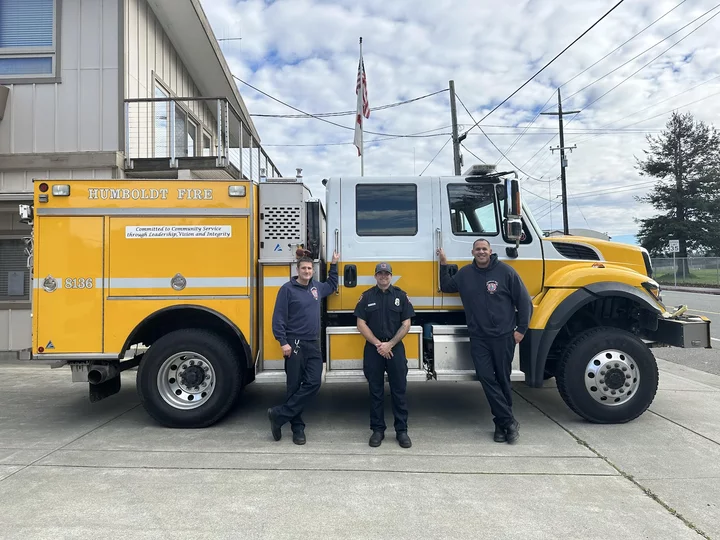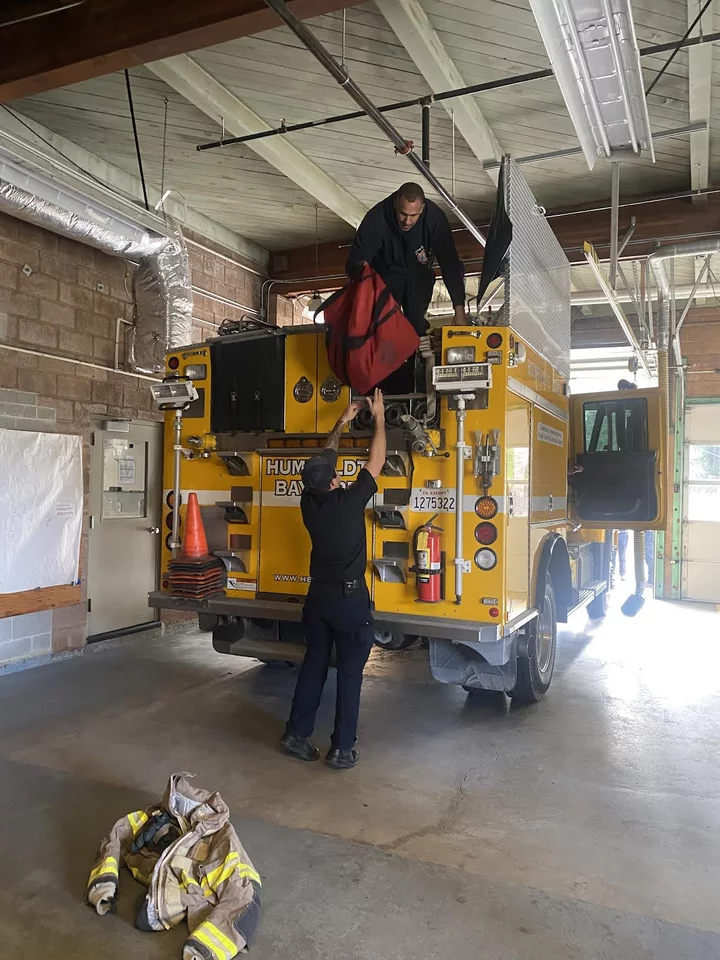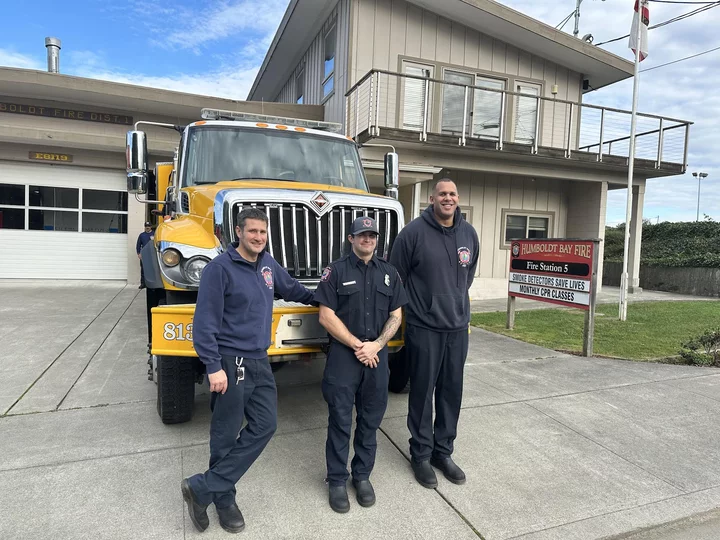FLIGHT PLAN! The Future of Humboldt County’s Airports Will Be Discussed at a Series of Meetings Later This Month
LoCO Staff / Thursday, Jan. 9, 2025 @ 11:09 a.m. / Airport
A jet taxis in at ACV. | File photo by Andrew Goff.
###
Press release from the Humboldt County Administrative Office:
Make your voice heard on local airport development plans at one of the Department of Aviation’s upcoming public open house meetings.
The Humboldt County Department of Aviation is updating its Airport System Plan Study for the six public-use airports it operates. This study, required by the Federal Aviation Administration (FAA), is a planning effort which outlines potential long-term development concepts to meet the needs of each airport, its users and the surrounding communities while adhering to current FAA design standards.
To share the draft study’s findings, the department will host four public open houses. These events offer an opportunity for residents and airport users to review the draft study, ask questions and provide feedback. Department of Aviation and airport consultant staff will be available at each meeting to answer questions.
How to Attend
Open houses to discuss the plan with the community will occur on Tuesday, Jan. 21 and Wednesday, Jan. 22 at the following times and locations:
- Murray Field Airport (EKA) on Tuesday, Jan. 21 from 10 to 11:30 a.m.
- California Redwood Coast-Humboldt County Airport (ACV) on Tuesday Jan. 21 from 4 to 6:30 p.m.
- Rohnerville Airport (FOT) on Wednesday, Jan. 22 from 10 to 11 a.m.
- Garberville Airport (O16) on Wednesday, Jan. 22 from 2 to 3 p.m.All interested community members are encouraged to attend and share their input.
For more information and background on the Humboldt Airport System Plan Study and how to share your input on the draft study, please call 707-839-5401 or email aviation@co.humboldt.ca.us.
Please note that public restrooms will not be available at the Murry Field, Rohnerville and Garberville airport locations. Attendees are encouraged to plan accordingly.The County of Humboldt is committed to providing equal access to all county programs, services and activities through the provision of accommodations for individuals with qualified disabilities as required under the Americans with Disabilities Act (ADA). With 72 hours prior notice, a request for reasonable accommodation for the public meetings can be made by calling 707-839-5401.
For more information on the Humboldt County Department of Aviation, please visit FlyACV.com.
BOOKED
Today: 8 felonies, 17 misdemeanors, 0 infractions
JUDGED
Humboldt County Superior Court Calendar: Today
CHP REPORTS
No current incidents
ELSEWHERE
Fishing the North Coast : Rising rivers reset coastal steelhead conditions
RHBB: King Salmon Flooding Seen During Thursday Morning High Tide, Higher Tides Expected
RHBB: Flooding and Road Closures Reported Across Humboldt County on New Year’s Day
KINS’s Talk Shop: Talkshop January 1st, 2026 – William Honsal
SNEAKY: It is Once Again Time to Be Extra Cautious on Humboldt’s Beaches
Andrew Goff / Thursday, Jan. 9, 2025 @ 9:45 a.m. / How ‘Bout That Weather
LA Fires Underscore How Much California Has to Lose if Trump Withholds Disaster Aid
Ryan Sabalow and Alexei Koseff / Thursday, Jan. 9, 2025 @ 7:40 a.m. / Sacramento
Photo: CalFire, via Flickr.
As wildfires erupted in Southern California, so did a years-long feud between incoming president Donald Trump and Gov. Gavin Newsom.On the campaign trail, Trump repeatedly threatened to cut off disaster funding for California.
He stopped short of that on Wednesday, but in a social media post, he called Newsom “Newscum” and blamed his water policies for the three fires that have destroyed hundreds of homes, killed at least five people and displaced tens of thousands of Californians.
Trump said that due to Newsom’s environmental regulations, not enough water has reached Southern California and that fire hydrants went dry as a result.
“Now the ultimate price is being paid,” he said. “I will demand that this incompetent governor allow beautiful, clean fresh water to FLOW INTO CALIFORNIA. He is to blame for this.”
The Newsom administration called Trump’s post “pure fiction.”
Wildfire and climate experts say natural conditions — including eight months of drought — are to blame.
“The issue here is that it hasn’t rained yet,” said Alexander Gershunov, a research meteorologist at UC San Diego’s Scripps Institution of Oceanography.
Plus, these fires have been pushed by Santa Ana wind gusts as high as 75 mph. In those conditions, burning embers can blow miles from their ignition source and entire neighborhoods can erupt in minutes.
“You’ll never have enough water to put out a Santa Ana fire,” said Zeke Lunder, a California wildfire expert who’s been tracking and mapping the fires’ progress.
The bigger question looming over California is whether Trump’s feud with Newsom will cause him to act on his promise to cut federal disaster aid to the state when he takes office on Jan. 20.
On the campaign trail last year, Trump vowed that “we won’t give (Newsom) money to put out all his fires” unless the Democratic governor agreed to divert more water to California farmers. Two former Trump administration officials later told Politico that Trump initially withheld approval for disaster aid for California’s deadly 2018 wildfires, until aides showed him that many of the residents of the affected areas had voted for him.
A president can slow down the process of approving aid, or not declare a disaster, a decision critical to a state receiving federal relief funding. A 2021 federal report found that the Trump administration delayed $20 billion in disaster aid to Puerto Rico after Hurricane Maria in 2017.
Federal funding typically pays for around 75% of the costs of rebuilding public infrastructure such as roads, sewers, water systems, parks and fire stations, officials say. That means California would have to come up with billions of dollars in additional money after major disasters if Trump follows through on his campaign rhetoric.
Federal disaster funds also help those who’ve lost their homes find temporary living quarters. Federal programs can help with home-rebuilding costs not covered by private insurance.
Newsom preparing for uncertain disaster funding
Newsom has taken Trump’s threats seriously enough that, in the fall, his administration began developing plans to establish a backup emergency response fund that the state could draw from if Trump refused to make federal aid available. It’s unclear if Newsom will follow through with the idea in his formal budget proposal, which is expected Friday.
“What you see with the president-elect is, you know, fire and fury often signifying something. You see fire and fury often signifying nothing,” Newsom said at a press conference Monday, where he cautioned that California’s fiscal stability is uncertain under the incoming Trump administration. “And you have to sort of work through all of that.”
On Wednesday, the outgoing Biden administration pledged federal help and is already sending disaster aid to the state, thanks to the $100 billion Congress approved in December.
President Joe Biden, who was already in California to designate a new national monument and for the birth of his great-grandson, made a brief public appearance at a Santa Monica fire station on Wednesday morning to pledge his support for the response.
“We’re prepared to do anything and everything, as long as it takes, to tame these fires and help reconstruct and make sure we get back to normal,” Biden said. “It’s going to be a hell of a long way. It’s going to take time.”Newsom, who joined Biden, said the president’s quick declaration of a major disaster “means the world to us.”
“It’s impossible for me to express the level of appreciation and cooperation we received from the White House and this administration,” Newsom said. “So on behalf of all of us, Mr. President, thank you for being here. And not just being here today. Thank you for being here since the minute of this incident.”
Most of California’s congressional delegation — including U.S. Sens. Alex Padilla and Adam Schiff and 47 House members, both Democrats and Republicans — signed onto a letter urging Biden to approve the declaration Wednesday.
“The severity of these wildfires requires additional coordination and a wider range of long-term federal recovery programs,” the lawmakers wrote.
When asked Wednesday about Trump’s past threats to withhold disaster aid to California, Padilla warned that “our response to these disasters cannot become a partisan issue, and I will continue fighting to secure the necessary resources for our state’s recovery.”
How federal money rebuilt Paradise, Santa Rosa
In communities such as Paradise and Santa Rosa that suffered through similar catastrophic fires within the past decade, officials there said their communities wouldn’t have been able to rebuild without federal help.
“If we hadn’t had those types of funds to do the basic infrastructure that we’ve already done and are currently doing, I don’t think we would have recovered at all. It is such a significant piece of recovery,” said Collette Curtis, the recovery and economic development director for the town of Paradise. An early morning fire on Nov. 8, 2018 pushed by powerful winds destroyed most of the town in a matter of hours. Eighty-five people died; 18,000 buildings were destroyed.
Curstis estimates that Paradise has received at least $375 million in federal aid since the fire.
A year before the Paradise fire, thousands of homes in the city of Santa Rosa and surrounding communities burned in the Tubbs Fire – another wind-driven inferno that killed 22 people.
The federal government provided at least $366 million in direct aid to communities affected by the Tubbs Fire and other fires that year, according to estimates from the office of U.S. Rep. Mike Thompson, a Democrat who represents the region. Santa Rosa alone received $218 million, said Assistant City Manager Jason Nutt.
Without that much federal help, Santa Rosa wouldn’t have recovered, said the city’s former mayor, Chris Rogers, who was just sworn in as the region’s Democratic Assemblymember.
“Without the help of the federal government, not only would we potentially not have been able to rebuild, but we certainly wouldn’t have been able to rebuild as quickly,” Rogers said.
Rogers called Trump’s threat to cut disaster funding for California communities “inhuman.”
“This is a time when people need the most support, when they’ve lost everything,” Rogers said. “That’s the time when they need government to function for them. And so, to me, it’s completely unconscionable that you would choose that as not just to make a statement, but as a leverage point to try to get other things that you want. It’s wildly inappropriate.”
###
CalMatters reporters Stella Yu and Alastair Bland contributed to this story.
CalMatters.org is a nonprofit, nonpartisan media venture explaining California policies and politics.
OBITUARY: Cindy Miller, 1960-2025
LoCO Staff / Thursday, Jan. 9, 2025 @ 6:56 a.m. / Obits
Cindy Miller, born Cynthia Jean Oldham, on May 22, 1960, passed away on Friday, January 3, in St. Joseph Hospital, the same hospital where she was born.
Cindy is survived by her significant other, Tom Browning; son, Brandon Canonica; granddaughter, Crystal Canonica; great-granddaughter Audrey Rogers; her dad, Ray Oldham, sisters and their families Victoria Shatwell (Ken) and Debbie Oldham-Auker (Jim), numerous nieces and nephews and lastly, but certainly not least, her fur babies, Ozzy, Yoda and Oreo. She is preceded in death by her mom, Marilyn Oldham, and husbands, Fred Canonica and Don Miller.
Growing up in Eureka, Cindy attended Alice Birney Elementary School, where she played the clarinet and participated in Girl Scouts, Jacobs Jr. High School and Eureka Senior High School. She was a member of the graduating Class of 1978 and enjoyed attending their class reunions. She spent her younger years camping every summer with her family in Southern Humboldt County at French’s Campground, sunbathing on the Eel River, riding a mini bike, square dancing and roasting marshmallows over an open fire. Cindy has remained friends with those whose families also camped at French’s.
Shortly after high school Cindy married and moved to Bamburg, Germany, where her husband was stationed in the Army. Bamburg is where her son, Brandon, was born. While there, they once took a trip, with other Army families to Paris, France. This was in the middle of summer on a bus without air-conditioning … an adventure to say the least. They also got to experienced a traditional German wedding and reception “Prost!” As was Cindy’s style, she remained friends with several of those she met while in Germany.
Cindy was a huge NASCAR fan, Kevin Harvick to be specific. She rarely missed a race on TV. During the season, her weekends were planned around the races. She also enjoyed attending the races at Redwood Acres. Cindy attended different car shows in Northern California/Southern Oregon as a member of the Turd Heads, with her parents. Cindy was helpful with the logistics of putting on Cruz’n Eureka Car Show and the auctions they held that benefited Boys and Girls Club of the Redwoods.
Arts and crafts were her passion She enjoyed it all and was very creative and skilled at her “craft.” She most recently was enjoying painting rocks, hiding them and finding others’ painted rocks others around Humboldt County. She was a member of several rock-painting groups.
Rather than flowers, if you’d like to make a donation on Cindy’s behalf, Hospice of Humboldt, Wounded Warriors, St Jude’s or the Sequoia Humane Society are organizations that had a special meaning to her.
We will have a celebration of life to remember and honor Cindy in May, around her birthday.
###
The obituary above was submitted on behalf of Cindy Miller’s loved ones. The Lost Coast Outpost runs obituaries of Humboldt County residents at no charge. See guidelines here. Email news@lostcoastoutpost.com.
OBITUARY: Joseph Ryan Peters, 1977-2024
LoCO Staff / Thursday, Jan. 9, 2025 @ 6:56 a.m. / Obits
On October 9, 2024, Humboldt County lost an extraordinary friend, IT
guy, shark-and-snark-loving, snuggable bear of a man. Joseph Ryan
Peters, known as Ryan, was born May 10, 1977 in Mountain View to
Martha S. Peters and John R. Peters, and grew up in the Bay Area. He
graduated from Cupertino High School, Cupertino, in 1995.
An ex-girlfriend and life circumstances brought Ryan first to Garberville, where he honed his IT skills and earned four Associates of the Arts degrees from College of the Redwoods:
- College of the Redwoods, Eureka. Received an Associate in Arts in Transfer Studies, 12/15/2000
- College of the Redwoods, Eureka. Received an Associate in Arts in Natural Science/Mathematics 12/15/2000
- College of the Redwoods, Eureka. Received an Associate in Arts in Humanities 12/15/2000
- College of the Redwoods, Eureka. Received an Associate in Arts in Social Science 12/15/2000
He eventually made his way north to Eureka, where he made his mark on the community around him.
He worked as the entire IT department of RCAA since 2009, shouldering the responsibility of keeping this non-profit’s tech and internet access running smoothly with his remarkable skills in computer sciences. He was a dependable and tireless volunteer for the local community, pouring countless hours into Kinetics, the IMPropriety Society and fetish nights. Ryan took on jobs others didn’t want to do and managed them with his stubborn, and some(often)times snarky persistence.
While these above details matter, none of them matter as much as the kind of friend that Ryan was. He was the friend who could be counted on to show up in a moment of crisis. He was the ultimate problem-solver and shared this skill with those he loved. He was immensely huggable, and had a contagious giggle (Whiskey Shits! IYKYK). He was one of the best shit-talkers known to man, and loved nothing more than a good gossip session. His loyalty was unreserved — if he loved you, it was for life.
Of course, no one is perfect, and Ryan was no exception. He could offer the sassiest advice and commentary on your life; it sometimes stung but you always knew he was right. His beautiful tenacity could turn into stubborn resistance — he dug his heels in like nobody’s business! He was filled with contradictions: a gun-loving, motorcycle-riding, nerdy leftist.
With his death we strive to remember those aspects of him that brought the most joy and will be the most missed: an insatiable curiosity about the sciences, art, music, and people; a deep love for animals, particularly birds and sharks; immense knowledge and wisdom; a sassy, quick-wit; loyalty and trustworthiness; insane creativity; the best giggle in town; and a hug that could comfort the most anxious among us.
Joseph Ryan Peters is survived by his mother, Martha S. Peters, San Jose, father, John R. Peters, Gresham, Oregon, brothers, John and James of San Jose, the late Mr. & Mrs. H. F. Strickland of Gainesville, Florida and the late Mr. & Mrs. John Peters of Snellville, Georgia.
His large circle of friends who became family include: Kati, Nawdy, Q and Yvonne, Diamond and Griff, Laura and Ryan, Maxwell and Teresa, SuperK8 and Silas, Gin, Cas, Julia, Tina, Natalie and too many more to list. Please join this motley crew in a remembrance of Ry’s life on Sunday, January 19, 11 a.m. at Synapsis, 1675 Union St, Eureka.
###
The obituary above was submitted on behalf of Ryan Peters’ loved ones. The Lost Coast Outpost runs obituaries of Humboldt County residents at no charge. See guidelines here. Email news@lostcoastoutpost.com.
Design Review Committee Narrowly Approves New Plans for Eureka’s EaRTH Center
Isabella Vanderheiden / Wednesday, Jan. 8, 2025 @ 4:43 p.m. / Housing , Local Government
The Eureka Design Review Committee. From left to right: Gailey Browning, Kassidy Banducci, Chuck Ellsworth and Ryan Cameron. | Image: Screenshot
###
At a public hearing this morning, Eureka’s Design Review Committee narrowly approved new design plans for the long-awaited EaRTH Center, a four-story housing and transit development slated for two city-owned parking lots on Third Street between G and H streets, behind Lost Coast Brewery.
The EaRTH Center — shorthand for the Eureka Regional Transit & Housing Center — will host the Humboldt Transit Authority’s regional transportation hub on its ground floor, plus five commercial spaces for businesses. The upper floors will feature 46 residential units designated for low- and very-low-income households, including three studios, 18 one-bedroom, 13 two-bedroom and 12 three-bedroom apartments. Residents will have access to communal amenities on the second floor, including a community room with a kitchen, a fitness room, and a large outdoor terrace with a playground.
The northeast corner (Third and G streets) of the EaRTH Center depicted in the Servitas proposal (left) and Danco (right). | Images via City of Eureka
The project has changed quite a bit since it was approved in February 2022 by the Eureka City Council, as seen in the renderings above. When plans for the EaRTH Center were drawn up a few years ago, the development was billed as a 30-unit housing project for students and traveling medical staff. At that time, the city was working with Cal Poly Humboldt and Servitas, a student housing management company, to create much-needed housing for incoming students. However, the university and Servitas later left the project due to expenses.
The city briefly considered a partnership with College of the Redwoods, but the slow approval process for obtaining the necessary grant funding led the city to look elsewhere. Eager to get the project back on track, city staff asked if Danco would be interested in taking over the project, and in June 2024, the city council unanimously approved a resolution that authorized the City Manager to enter negotiations with Danco Communities for a Disposition and Development Agreement (DDA).
The redesign includes significant changes to the building’s façade and exterior, with a concrete base and green metal siding on the upper floors. Senior Planner Lisa Savage said the modified plans include new bus shelters along H Street, expanded sidewalks and electric vehicle charging stations.
“There also be a major [re]configuration of H Street between Third and Fourth streets,” Savage told the committee. “The west lane – where the bus shelter currently is located – will become a bus-only lane, and a new bike lane will run on the eastern side of the street. The current street parking configuration on the east side of H Street between Third and the alley [behind Lost Coast Brewery] will change from angled to parallel, which will cause the street to be reduced to one lane [for regular traffic] in this section.”
The reconfiguration will further reduce parking near the EaRTH Center, an issue many downtown and Old Town business owners have expressed concern about since it was first proposed.
Committee Vice-Chair Gailey Browning asked how many additional parking spots would be removed from Third Street under the current plan. Savage said the reconfiguration would eliminate parking on the south and east sides of the project, but she could not provide an exact number.
Committee member Chuck Ellsworth asked why Danco had decided to change the design, noting that the original rendering was “much more compatible with the community.”
Caitlin Castellano, the city’s deputy director of development services, noted that the previous rendering had been created by the former developer, Servitas, and that Danco decided to adopt a different, more cost-effective design. “There was no requirement by the city council or the Humboldt Transit Authority to retain the original design,” she added.
Browning felt the modified design was “inharmonious” with the rest of Old Town. “I think this is such an important project that there’s room for improvement on it,” she said. “I think the roof pitches could be more dramatic, I think they could add more window trim, I think the horizontal [and vertical] banding could be more pronounced. … I think the deck is a lovely edition, but I’d love to see some iron railing to pronounce that there’s a deck because you really can’t tell that it is from afar.”
Ellsworth seemed to agree, referring to the current rendering as a “cookie-cutter design.” He emphasized his support for the EaRTH Center but said, “It’s [in the] wrong place and it’s the wrong design for the community in that area.”
Committee member Ryan Cameron said he liked the building “overall” but asked if the developer would be willing to incorporate brick into the design to match some of the buildings nearby.
Garrett McSorley, the project’s current architect, pushed back on the committee’s assertion that his design is a “cookie-cutter” project. “From my perspective, this is a very high-quality project,” he said.
“We can incorporate different materials,” McSorely continued. “You know, brick is definitely one of the things that we talked about early on in the process but we found that brick is a budget-buster. It’s very, very expensive and it doesn’t provide the [degree] of long-term maintenance that the materials we have shown are. … Repeating and using the same materials that are already there in Old Town doesn’t necessarily respect Old Town. … We’re just a block down from the Carson Block Building – a gem of a building – and trying to repeat and copy that building would be a mistake, in my opinion.”
McSorely acknowledged that the metal siding may look “flat” in the digital renderings, but said it will look “more interesting” in real life. He also expressed interest in incorporating a pattern or design into the concrete base on the ground floor of the building.
Browning asked McSorley if he would be willing to increase the pitch of the roof to provide a more dynamic design. Again, he acknowledged that the digital rendering “looks boring” but advised against upping the pitch because it would increase shading. Increasing the pitch could also interfere with the solar panels that will be installed on the roof of the building, he said.
“These projects are net zero energy,” he continued. “The families who [will] live [t]here [will] have utility bills of, like, $10 a month and the way that’s done is through the roof design. If we wanted to create a full new roof with, you know, spires and different gables, those all drastically reduced the amount of solar panels we could fit in the project and it has a dramatic impact on the residents in the future.”
During the public comment period, nearly all of the speakers spoke in favor of the project, underscoring the need for more affordable housing in Eureka. One speaker called the modified project design a “bait and switch,” comparing the new rendering to the veteran’s resource center on Fourth Street, across the street from the North Coast Co-op. “That’s probably one of the least attractive buildings in Eureka, in my opinion,” he said.
After a bit of discussion among committee members, Chair Kassidy Banducci made a motion to approve the modified design, which was seconded by Cameron. The motion failed in a 2-2 vote, with Browning and Ellsworth dissenting.
Development Services Director Cristin Kenyon advised the committee to come up with a new motion, otherwise, its decision to deny the project design would almost certainly be appealed to the Eureka Planning Commission.
The committee rehashed some of the design elements with the architect and came up with a short list of modifications to the project, including wood paneling at the building’s main entrance and thicker horizontal banding between floors on the façade.
Before the committee could take a second vote, Browning left for an appointment. After a bit of additional discussion, Banducci came up with a motion that passed 2-1, with Ellsworth dissenting.
###
Humboldt Bay Fire Engine Dispatched to Help Battle SoCal Wildfires
LoCO Staff / Wednesday, Jan. 8, 2025 @ 2:05 p.m. / Fire
Humboldt Bay Fire release:
This morning Humboldt Bay Fire was requested to assist with an available engine to respond to the Palisades Fire in Los Angeles County. Our Type 3 Engine as well as an Engine from Fortuna Fire are leaving Humboldt County to meet with a group of three Sonoma County fire engines in Petaluma. From there all five engines and a strike team leader will be driving through the night to LA.
Once at the Palisades Fire, our crew and the rest of the strike team will likely go directly to work. Humboldt Bay Fire is happy to provide apparatus and personnel to any agency in need, and we know that would be reciprocated. Working under unified command, all crews will be hard at work to prevent any further devastation to the Los Angeles County affected area. HBF hopes all personnel involved remain safe and return home.


